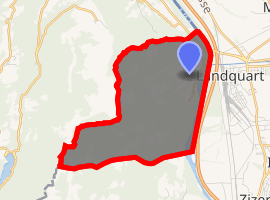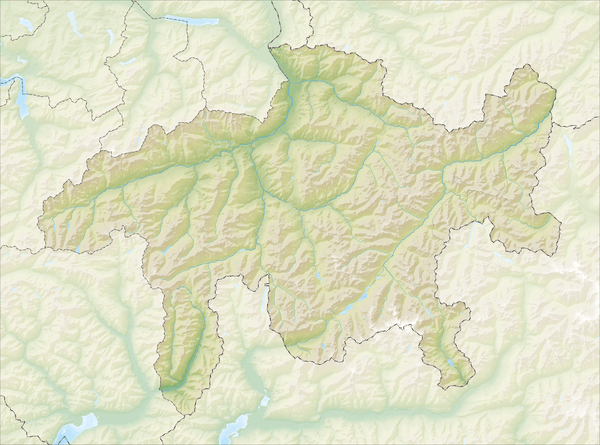Mastrils
Mastrils is a former municipality in the district of Landquart in the Swiss canton of Graubünden. The municipalities of Igis and Mastrils merged on 1 January 2012 into the new municipality of Landquart.[1]
Mastrils | |
|---|---|
 | |
 Coat of arms | |
Location of Mastrils 
| |
 Mastrils  Mastrils | |
| Coordinates: 46°58′N 9°32′E | |
| Country | Switzerland |
| Canton | Graubünden |
| District | Landquart |
| Area | |
| • Total | 7.98 km2 (3.08 sq mi) |
| Elevation | 550 m (1,800 ft) |
| Population (December 2018) | |
| • Total | 548 |
| • Density | 69/km2 (180/sq mi) |
| Postal code | 7303 |
| SFOS number | 3943 |
| Surrounded by | Bad Ragaz (SG), Igis, Maienfeld, Pfäfers (SG), Untervaz, Zizers |
| Website | www SFSO statistics |
History
Mastrils is first mentioned in 1318 as Ponstrils. In 1345 it was mentioned as Bastrils.[2] In 1854 the municipality separated from Zizers to become an independent municipality.[1]
Geography


Mastrils has an area, as of 2006, of 8 km2 (3.1 sq mi). Of this area, 23.9% is used for agricultural purposes, while 68.8% is forested. Of the rest of the land, 2.5% is settled (buildings or roads) and the remainder (4.9%) is non-productive (rivers, glaciers or mountains).[3]
The municipality is located in the Fünf Dörfer sub-district of the Landquart district. It is a widely scattered settlement on in the foothills of the Calanda mountains. It consists of the settlements of Isla, Tardisbrücke and Trätsch.
Demographics
Mastrils has a population (as of 31 December 2018) of 548.[4] As of 2008, 8.5% of the population was made up of foreign nationals.[5] Over the last 10 years the population has grown at a rate of 1.1%. Most of the population (as of 2000) speaks German (93.0%), with Italian being second most common ( 1.9%) and Romansh being third ( 1.5%).[3]
As of 2000, the gender distribution of the population was 49.4% male and 50.6% female.[6] The age distribution, as of 2000, in Mastrils is; 54 children or 10.2% of the population are between 0 and 9 years old. 31 teenagers or 5.9% are 10 to 14, and 48 teenagers or 9.1% are 15 to 19. Of the adult population, 53 people or 10.0% of the population are between 20 and 29 years old. 88 people or 16.6% are 30 to 39, 86 people or 16.3% are 40 to 49, and 82 people or 15.5% are 50 to 59. The senior population distribution is 38 people or 7.2% of the population are between 60 and 69 years old, 38 people or 7.2% are 70 to 79, there are 10 people or 1.9% who are 80 to 89, and there are 1 people or 0.2% who are 90 to 99.[5]
In the 2007 federal election the most popular party was the SVP which received 35.8% of the vote. The next three most popular parties were the SP (29%), the CVP (14.8%) and the FDP (14.4%).[3]
The entire Swiss population is generally well educated. In Mastrils about 71.8% of the population (between age 25-64) have completed either non-mandatory upper secondary education or additional higher education (either university or a Fachhochschule).[3]
Mastrils has an unemployment rate of 1.08%. As of 2005, there were 36 people employed in the primary economic sector and about 16 businesses involved in this sector. 14 people are employed in the secondary sector and there are 5 businesses in this sector. 44 people are employed in the tertiary sector, with 12 businesses in this sector.[3]
The historical population is given in the following table:[2]
| year | population |
|---|---|
| 1850 | 460 |
| 1900 | 322 |
| 1950 | 433 |
| 1970 | 464 |
| 1990 | 585 |
| 2000 | 529 |
References
- Amtliches Gemeindeverzeichnis der Schweiz published by the Swiss Federal Statistical Office (in German) accessed 21 December 2011
- Mastrils in German, French and Italian in the online Historical Dictionary of Switzerland.
- Swiss Federal Statistical Office Archived 2011-11-16 at the Wayback Machine accessed 15-Oct-2009
- Swiss Federal Statistical Office - STAT-TAB, online database – Ständige und nichtständige Wohnbevölkerung nach institutionellen Gliederungen, Geburtsort und Staatsangehörigkeit (in German) accessed 23 September 2019
- Graubunden Population Statistics Archived 2009-08-27 at the Wayback Machine (in German) accessed 21 September 2009
- Graubunden in Numbers Archived 2009-09-24 at the Wayback Machine (in German) accessed 21 September 2009
| Wikimedia Commons has media related to Mastrils. |